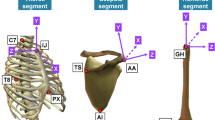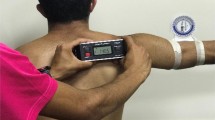Abstract
Purpose
Throwing a baseball requires a coordinated sequence of scapula and humerus movements also called scapulo-humeral rhythm (SHR). Fatigue associated with repetitive throwing can lead to scapular dyskinesia, a recognized cause of shoulder disability in pitchers and overhead athletes. We introduce a novel device, the Xbus Kit, which can objectively assess scapular biomechanics and the effect of pitching on SHR.
Methods
SHR was studied using the Xbus Kit (Xsens Technologies B.V., NL). Thirteen collegiate baseball pitchers (aged 20 ± 2.6) were studied, evaluating SHR in forward elevation and abduction in three sessions: before throwing (S1), after 60 pitches (S2) and 24 h after a pitching session (S3).
Results
SHR changes were found in 85 % of pitchers (11 cases), and no changes were observed in 2 cases (15 %). We were able to subdivide pitchers into four groups, based on their response to pitching.
Conclusion
Repetitive movement of pitching leads to SHR changes and sometimes, incomplete restoration of normal shoulder biomechanics.








Similar content being viewed by others
References
Sauers E (2001) Theories on throwing injuries diverge from book of Jobe. Biomechanics 8:61–66
Burkhart SS, Morgan CD, Kibler WB (2003) The disabled throwing shoulder: spectrum of pathology Part I: pathoanatomy and biomechanics. Arthroscopy 19:404–420
Bagg SD, Forrest WJ (1986) Electromyographic study of the scapular rotators during arm abduction in the scapular plane. Am J Phys Med 65:111–124
Bagg SD, Forrest WJ (1988) A biomechanical analysis of scapular rotation during arm abduction in the scapular plane. Am J Phys Med Rehabil 67:238–245
Kibler WB, McMullen J (2003) Scapular dyskinesis and its relation to shoulder pain. J Am Acad Orthop Surg 11:142–151
Pradhan RL, Itoi E, Hatakeyama Y, Urayama M, Sato K (2001) Superior labral strain during the throwing motion. A cadaveric study. Am J Sports Med 29:488–492
Shepard MF, Dugas JR, Zeng N, Andrews JR (2004) Differences in the ultimate strength of the biceps anchor and the generation of type II superior labral anterior posterior lesions in a cadaveric model. Am J Sports Med 32:1197–1201
Cutti AG, Giovanardi A, Rocchi L, Davalli A, Sacchetti R (2008) Ambulatory measurement of shoulder and elbow kinematics through inertial and magnetic sensors. Med Biol Eng Comput 46:169–178
Wu GFC, Van der Helm T, Veeger HEJD et al (2005) ISB recommendation on definitions of joint coordinate systems of various joints for the reporting of human joint motion-Part II: shoulder, elbow, wrist and hand. J Biomech 38:981–992
Jobe C, Pink M, Jobe F, Shaffer B (1996) Anterior shoulder instability, impingement, and rotator cuff tear: theories and concepts. In: Jobe F (ed) Operative techniques in upper extremity sports injuries. Mosby-Year Book, St. Louis, pp 164–176
Kvitne RS, Jobe FW (1993) The diagnosis and treatment of anterior instability in the throwing athlete. Clin Orthop Relat Res 107–123
Pink M, Jobe F (1991) Shoulder injuries in athletes. Clin Manage 11:39–47
Inman VT, Saunders JB, Abbott LC (1996) Observations of the function of the shoulder joint. Clin Orthop Relat Res 3–12
Kibler WB, Sciascia A (2010) Current concepts: scapular dyskinesis. Br J Sports Med 44:300–305
Miyashita K, Kobayashi H, Koshida S, Urabe Y (2010) Glenohumeral, scapular, and thoracic angles at maximum shoulder external rotation in throwing. Am J Sports Med 38:363–368
Myers JB, Laudner KG, Pasquale MR, Bradley JP, Lephart SM (2005) Scapular position and orientation in throwing athletes. Am J Sports Med 33:263–271
Meyer KE, Saether EE, Soiney EK et al (2008) Three-dimensional scapular kinematics during the throwing motion. J Appl Biomech 24:24–34
Escamilla R, Fleisig G, Barrentine S, Andrews J, Moorman C (2002) Kinematic and kinetic comparisons between American and Korean professional baseball pitchers. Sports Biomech 1:213–228
Garofalo P, Cutti A, Parel I, et al. (2010) Ambulatory measurement of the scapulohumeral rhythm: intra- and inter-rater reliability of a protocol based on inertial and magnetic sensors. In Assistive Technology Research Series 164–166
Ulrich MJH, Van Tuijl EAB, Cutti AG, Garofalo P, Veeger DJ (2010) Ambulatory measurement of the scapulothoracic motion: accuracy of a protocol based on inertial and magnetic sensors. Proc. ISG 2010, Minnesota
Conflict of interest
None.
Author information
Authors and Affiliations
Corresponding author
Rights and permissions
About this article
Cite this article
Pellegrini, A., Tonino, P., Paladini, P. et al. Motion analysis assessment of alterations in the scapulo-humeral rhythm after throwing in baseball pitchers. Musculoskelet Surg 97 (Suppl 1), 9–13 (2013). https://doi.org/10.1007/s12306-013-0253-4
Received:
Accepted:
Published:
Issue Date:
DOI: https://doi.org/10.1007/s12306-013-0253-4




